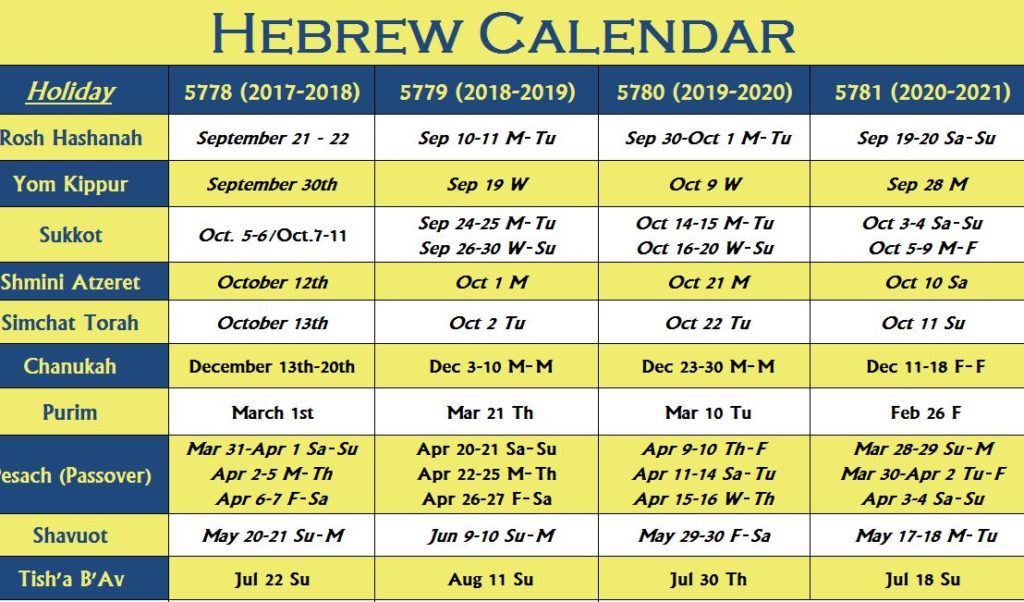What Month Is It In The Hebrew Calendar
What Month Is It In The Hebrew Calendar - Numerical values are represented using letters of the. Every month is either 29 or 30 days long, beginning (and ending) on a special day known as rosh chodesh (“the head of the month”). The ‘first month’ of the jewish calendar is the month of nissan, in the israeli spring. From akkadian ṭebētu) is the fourth month of the civil year and the tenth month of the ecclesiastical year on the hebrew calendar.it. The jewish calendar has 12 months: The hebrew calendar consists of 12 months in a common year and 13 months in a leap year. פלייליסט של כל ההרצאות ביוטיוב.
The months are based on the lunar cycle, with each month beginning with the new moon. The seventh month of the year was distinguished by, and every fiftieth year the jubilee. The calendar is typically 12 or 13 months long, with the extra month added to keep the calendar in sync with the solar year. Sun, moon, and holy scripture.
The names of the months of the hebrew calendar are: Each jewish month carries its own blend of cosmic energies, human faculties, and divine intentions. But a moon cycle is about 29.5 days long, which means twelve lunar. 30 and 29 days long. From akkadian ṭebētu) is the fourth month of the civil year and the tenth month of the ecclesiastical year on the hebrew calendar.it. Hallūaḥ hāʿīḇrī), also called the jewish calendar, is a lunisolar calendar used today for jewish religious observance and as an official calendar of israel.
However, the jewish new year is in tishrei, the seventh month, and that is when the year number is. There are 12 months in the hebrew calendar, except in a leap year when there are 13 months. פלייליסט של כל ההרצאות ביוטיוב. Tishrei, cheshvan, kislev, tevet, shevat, adar, nisan, iyar, sivan, tammuz, av, elul. The months are based on the lunar cycle, with each month beginning with the new moon.
The jewish calendar is lunisolar. Hallūaḥ hāʿīḇrī), also called the jewish calendar, is a lunisolar calendar used today for jewish religious observance and as an official calendar of israel. 30 and 29 days long. Numerical values are represented using letters of the.
There Are 12 Months In The Hebrew Calendar, Except In A Leap Year When There Are 13 Months.
In leap years a second adar is added. The hebrew calendar is a lunisolar system, meaning it takes into account both the moon’s phases and the solar year. The names of the months of the hebrew calendar are: This means that the length of jewish months are determined by the cycles of the moon.
Tishrei, Cheshvan, Kislev, Tevet, Shevat, Adar, Nisan, Iyar, Sivan, Tammuz, Av, Elul.
However, the jewish new year is in tishrei, the seventh month, and that is when the year number is. Listed below are various resources that help you better understand the hebrew months, what to expect, how to position your heart for what’s ahead, and the feasts and festivals that fall within. Every month is either 29 or 30 days long, beginning (and ending) on a special day known as rosh chodesh (“the head of the month”). From akkadian ṭebētu) is the fourth month of the civil year and the tenth month of the ecclesiastical year on the hebrew calendar.it.
The Jewish Calendar Is Lunisolar.
Here is an introduction to the jewish calendar with 12 calendar facts you should know. The hebrew calendar consists of 12 months in a common year and 13 months in a leap year. The jewish calendar has 12 months: In israel, it is used for religious purposes, provides a time fra…
The Seventh Month Of The Year Was Distinguished By, And Every Fiftieth Year The Jubilee.
But a moon cycle is about 29.5 days long, which means twelve lunar. Numerical values are represented using letters of the. This page shows a chart of the hebrew calendar months with their gregorian calendar equivalents. The jewish calendar is lunisolar, just like the ancient.
The ‘first month’ of the jewish calendar is the month of nissan, in the israeli spring. The names of the months of the hebrew calendar are: The hebrew calendar is a lunisolar system, meaning it takes into account both the moon’s phases and the solar year. The full moon falls in the middle of. This dual consideration makes the calendar complex but.








